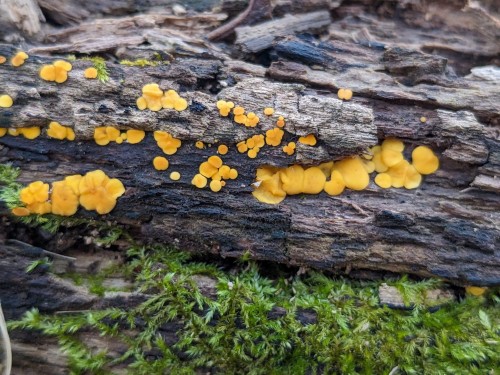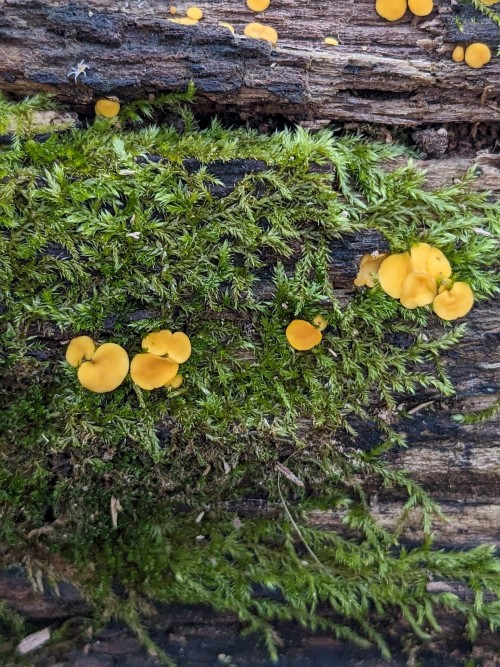
28/Female/Earthling- An amateur naturalist and geology major living in the Missouri Ozarks. Botany 🌿, mycology 🍄, geology 🏔️, foraging 🍓, gardening and more! 🌼🐦🦉🐝 😀 (Natural sciences are my niche.) •iNaturalist ID: oliviarosaline •Rockd Macrostrat Lab: Olivia Myers
86 posts
Yellow Fairy Cups


Yellow Fairy Cups
Calycina citrina syn. Bisporella citrina
November 22nd, 2023
St. Charles County, Missouri, USA
Olivia R. Myers
@oliviarosaline
-
 mycomantic reblogged this · 4 months ago
mycomantic reblogged this · 4 months ago -
 idrisstorey liked this · 4 months ago
idrisstorey liked this · 4 months ago -
 mrvynmeir liked this · 6 months ago
mrvynmeir liked this · 6 months ago -
 nessieac liked this · 6 months ago
nessieac liked this · 6 months ago -
 oc45 liked this · 6 months ago
oc45 liked this · 6 months ago -
 novemberful liked this · 6 months ago
novemberful liked this · 6 months ago -
 hcr-den liked this · 6 months ago
hcr-den liked this · 6 months ago -
 king-of-roses-world liked this · 6 months ago
king-of-roses-world liked this · 6 months ago -
 truepinkshape liked this · 6 months ago
truepinkshape liked this · 6 months ago -
 highonjen liked this · 6 months ago
highonjen liked this · 6 months ago -
 kkimura liked this · 6 months ago
kkimura liked this · 6 months ago -
 nevzatboyraz44 liked this · 6 months ago
nevzatboyraz44 liked this · 6 months ago -
 exactlycraftygoatee liked this · 6 months ago
exactlycraftygoatee liked this · 6 months ago -
 misterio-m liked this · 6 months ago
misterio-m liked this · 6 months ago -
 narihira8 liked this · 6 months ago
narihira8 liked this · 6 months ago -
 gloriousfartcupcake liked this · 6 months ago
gloriousfartcupcake liked this · 6 months ago -
 emaadsidiki liked this · 6 months ago
emaadsidiki liked this · 6 months ago -
 welufo liked this · 6 months ago
welufo liked this · 6 months ago -
 corse2b liked this · 6 months ago
corse2b liked this · 6 months ago -
 danielrexi reblogged this · 6 months ago
danielrexi reblogged this · 6 months ago -
 ginger-belle reblogged this · 7 months ago
ginger-belle reblogged this · 7 months ago -
 abdalla-23 liked this · 8 months ago
abdalla-23 liked this · 8 months ago -
 carnivorous-horses-lover reblogged this · 8 months ago
carnivorous-horses-lover reblogged this · 8 months ago -
 justalurkr reblogged this · 8 months ago
justalurkr reblogged this · 8 months ago -
 animate-mush reblogged this · 8 months ago
animate-mush reblogged this · 8 months ago -
 andrea28sworld liked this · 8 months ago
andrea28sworld liked this · 8 months ago -
 midnight-lovestruck reblogged this · 8 months ago
midnight-lovestruck reblogged this · 8 months ago -
 midnight-lovestruck liked this · 8 months ago
midnight-lovestruck liked this · 8 months ago -
 cleverauthorcookiecowboy liked this · 8 months ago
cleverauthorcookiecowboy liked this · 8 months ago -
 angelayasmim liked this · 8 months ago
angelayasmim liked this · 8 months ago -
 asikan liked this · 8 months ago
asikan liked this · 8 months ago -
 ledergummistiefelgay liked this · 8 months ago
ledergummistiefelgay liked this · 8 months ago -
 unknown-nugget27 liked this · 8 months ago
unknown-nugget27 liked this · 8 months ago -
 seashellsandteacups liked this · 8 months ago
seashellsandteacups liked this · 8 months ago -
 shhhit-t reblogged this · 8 months ago
shhhit-t reblogged this · 8 months ago -
 margocooper liked this · 8 months ago
margocooper liked this · 8 months ago -
 bio-zurgy reblogged this · 8 months ago
bio-zurgy reblogged this · 8 months ago -
 zurgy liked this · 8 months ago
zurgy liked this · 8 months ago -
 weebywitch94 liked this · 8 months ago
weebywitch94 liked this · 8 months ago -
 solemnrose reblogged this · 8 months ago
solemnrose reblogged this · 8 months ago -
 wolfy77moon liked this · 8 months ago
wolfy77moon liked this · 8 months ago -
 princessbuttercupoffairydonia liked this · 8 months ago
princessbuttercupoffairydonia liked this · 8 months ago -
 vuonkhuya liked this · 8 months ago
vuonkhuya liked this · 8 months ago -
 el-zorro-chile liked this · 8 months ago
el-zorro-chile liked this · 8 months ago -
 buglivesinmossyskull liked this · 8 months ago
buglivesinmossyskull liked this · 8 months ago -
 softtea reblogged this · 8 months ago
softtea reblogged this · 8 months ago -
 elfprincejames reblogged this · 8 months ago
elfprincejames reblogged this · 8 months ago
More Posts from Oliviarosaline

Mexican Hat
Ratibida columnifera
I found this lonely blooming Mexican hat plant gleaming like a beacon light amongst a sea of non-native, invasive teasel growing in a dry, disturbed, almost waste-like land near Interstate 55 in Missouri.
This sombrero-resembling prairie coneflower is native to North America, where its historic native range primarily spanned the Great Plains and surrounding areas to the west, to Missouri on the very eastern edge of its adventive range. However, there are now naturalized populations east of Missouri. It's commonly grown in gardens and can escape from them. This species prefers dry, sunny habitats such as prairies, savannas and some disturbed areas with well-drained, neutral to alkaline soils. Its flowers provide food for an array of insect species, including bees, beetles, moths, wasps, and many more.
June 20th, 2023
Arnold, Jefferson County, Missouri, USA
Olivia R. Myers
@oliviarosaline

#Wolves
I need to say a few words here about Wolves and their role in biodiversity. Because I like them, but most of all, they're a must in the wilderness.
Like every time we are standing on the edge of a hiking trail of a National Park, a protected territory, we all must beware of the consequences.
Au contrary to what most people may think of its surface, no matter how large it might be, isn't big enough to sustain a healthy Wolf population over a long term. This large Predator requires a massive home range to find the prey it needs to survive. Studies have shown that all the Wolf packs in Parks must travel outside its boundaries to meet their needs. And these large Canids are also victims of habitat degradation and fragmentation, not to mention deaths of human origin.
And for people who don't know, Wolves are considered as an umbrella species. Which means that efforts to protect it benefit the entire ecosystem, since the Wolf's territory encompasses the territories of many other species with a similar home range.
As for being an apex Predators, Wolves play an important role in biodiversity. Yes, their presence has been scientifically proven to increase the abundance and diversity of plants, mamal's Birds, Amphibiants, and Reptiles. Wolves help to control the amount of Prey on their territory; this prevents an overpopulation of herbivores, which could be detrimental to plant regrowth. Wolves also give a boost to several other animal species by leaving their partially carcasses for scavengers to feed on. Through its influence on the entire food chain and by curbing excessive grazing. So yes, the Wolf is a key species needed to preserve the balance of Ecosystem.
To conclude; Wolves are very wary and will run away from any human they detect through their remarkable senses of hearing and smell - they can sniff out their Prey from more than 2kms away. Several studies have shown that Wolves will try to avoid humans at all costs and flee when approached.
Just to say that all citizens have a responsibility to protect the Wolves.
your photos are beautiful! (and i love love love that you include species info)
Thank you! I love sharing information on my posts so others may learn with me... even if it's one small, interesting piece of info at a time. I really appreciate the compliment about my photos, too. :)

Fire Pink
Silene virginica
A perennial catchfly native to central and eastern North America. The bright, fiery red flowers attract ruby-throated hummingbirds to pollinate them, and sticky sepals and stems on the plant act as a trap for small insects trying to climb up it, hence the name "catchfly" for plants in this genus. It prefers somewhat dry soils and part-sun, so it can be found on rocky slopes in open woodlands, savannas, and other similar habitats.
I found this fire pink growing in open, rocky woods near blackjack oaks and other drought-tolerant species.
April 18th, 2024
St. Francois County, Missouri, USA
Olivia R. Myers
@oliviarosaline


Tall Thimbleweed
Anemone virginiana
This anemone is native to the United States and southern Canada, where its range extends primarily east of the Great Plains. Its common name originates from the cluster of pistils forming a thimble shape, and it can tolerate and grow in a variety of conditions. This particular plant was thriving in a partly sunny, moist area of the woods near a small creek.
June 22nd, 2023
St. Francois County, Missouri, USA
Olivia R. Myers
@oliviarosaline